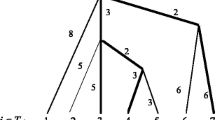Abstract
In this study we are concerned with the general problem of choosing from a set of endangered species T a subset S of k species to protect as a priority. Here, the interest to protect the species of S is assessed by the resulting expected phylogenetic diversity (ePD) of the set T, a widely used criterion for measuring the expected amount of evolutionary history associated with T. We consider that the survival of the protected species is assured and, on the contrary, that there is a risk of extinction for the unprotected species. The problem is easy to solve by a greedy type method if the extinction probabilities of the unprotected species are known but these probabilities are generally not easy to quantify. We show in this note that the choice of the precise values attributed to the extinction probabilities—provided it respects the rank of imperilment of each species—is not as decisive as might be feared for the considered problem. The values of these probabilities have a clear impact on the selection of the species to be protected but a little impact on the resulting ePD. More precisely, if T 1 and T 2 are the two optimal subsets of species corresponding to two scenarios (two different sets of probabilities) the ePDs of T 1 and T 2, calculated with the probabilities of the first scenario—or with the probabilities of the second scenario—are not very different.


Similar content being viewed by others
References
Cardinale BJ, Duffy JE, Gonzalez A, Hooper DU, Perrings C, Venail P, Narwani A, Mace GM, Tilman D, Wardle DA, Kinzig AP, Daily GC, Loreau M, Grace JB, Larigauderie A, Srivastava DS, Naeem S (2012) Biodiversity loss and its impact on humanity. Nature 486:59–67
Chao A, Chiu C-H, Jost L (2010) Phylogenetic diversity measures based on Hill numbers. Philos Trans R Soc B 365:3599–3609
Collen B (2015) Conservation prioritization in the context of uncertainty. Anim Conserv 18:315–317
Collen B, Pettorelli N, Baillie JEM, Durant SM (eds) (2013) Biodiversity monitoring and conservation: bridging the gap between global commitment and local action. Wiley-Blackwell, Hoboken
Convention on Biological Diversity (2011) Strategic plan for biodiversity 2011–2020, including Aichi biodiversity targets. http://www.cbd.int/sp/
Faith DP (1992a) Conservation evaluation and phylogenetic diversity. Biol Cons 61:1–10
Faith DP (1992b) Systematics and conservation: on predicting the feature diversity of subsets of taxa. Cladistics 8:361–373
Faith DP (2013) Biodiversity and evolutionary history: useful extensions of the PD phylogenetic diversity assessment framework. Ann N-Y Acad Sci 1289:69–89
Faith DP (2015) Phylogenetic diversity, functional trait diversity and extinction: avoiding tipping points and worst-case losses. Philos Trans R Soc B 370:20140011
Faith DP (2016) The PD phylogenetic diversity framework: linking evolutionary history to feature diversity for biodiversity conservation. In: Pellens R, Grandcolas P (eds) Biodiversity conservation and phylogenetic systematics, topics in biodiversity and conservation 14. Springer, Cham
Forest F, Crandall KA, Chase MW, Faith DP (2015) Phylogeny, extinction and conservation: embracing uncertainties in a time of urgency. Philos Trans R Soc B 370:20140002
Hartmann K, Steel M (2006) Maximizing phylogenetic diversity in biodiversity conservation: greedy solutions to the Noah’s Ark Problem. Syst Biol 55:644–651
Hartmann K, Steel M (2007) Phylogenetic diversity: from combinatorics to ecology. In: Gascuel O, Steel M (eds) Reconstructing evolution: new mathematical and computational advances. Oxford University Press, Oxford
Isaac NJB, Turvey ST, Collen B, Waterman C, Baillie JEM (2007) Mammals on the EDGE: conservation priorities based on threat and phylogeny. PLoS ONE 2(3):e296
IUCN (2012) IUCN Red List categories and criteria: version 3.1. Second edition. IUCN, Gland, Cambridge, iv + 32 pp
Jensen EL, Mooers AO, Caccone A, Russello MA (2016) I-HEDGE: determining the optimum complementary sets of taxa for conservation using evolutionary isolation. PeerJ 4:e2350
Mace GM, Collar NJ, Gaston KJ, Hilton-Taylor C, Akçakaya HR, Leader-Williams N, Milner-Gulland EJ, Stuart SN (2008) Quantification of extinction risk: IUCN’s system for classifying threatened species. Conserv Biol 22:1424–1442
MacLaurin J, Sterelny K (2008) What is biodiversity?. The University of Chicago Press, Chicago, p 217
Mimouni E, Beisner BE, Pinel-Alloul B (2016) Phylogenetic diversity and its conservation in the presence of phylogenetic uncertainty: a case study of cladoceran communities in urban waterbodies. Biodivers Conserv 25:2113–2136
Mooers AO, Faith DP, Maddison WP (2008) Converting endangered species categories to probabilities of extinction for phylogenetic conservation prioritization. PLoS ONE 3:e3700
Moreno CE et al (2017) Measuring biodiversity in the Anthropocene: a simple guide to helpful methods. Biodivers Conserv 26(12):2993–2998
Nunes LA, Turvey ST, Rosindell J (2015) The price of conserving avian phylogenetic diversity: a global prioritization approach. Philos Trans R Soc B. https://doi.org/10.1098/Rstb.2014.0004
Pardi F (2009) Algorithms on phylogenetic trees. PhD thesis, University of Cambridge
Pellens R, Grandcolas P (eds) (2016) Biodiversity conservation and phylogenetic systematics: preserving our evolutionary heritage in an extinction crisis. Springer International Publishing, Springer Open, Berlin, p 390
Redding RW, Mooers AO (2006) Incorporating phylogenetic measures into conservation prioritization. Cons Biol 20:1670–1678
Steel M, Mimoto A, Mooers AO (2007) Hedging our bets: the expected contribution of species to future phylogenetic diversity. Evol Bioinform 3:237–244
Stork NE (2010) Re-assessing current extinction rates. Biodivers Conserv 19:357–371
Weitzman ML (1998) The Noah’s ark problem. Econometrica 66:1279–1298
Witting L, Loeschcke V (1995) The optimization of biodiversity conservation. Biol Conserv 71:205–207
Author information
Authors and Affiliations
Corresponding author
Additional information
Communicated by David Hawksworth.
This article belongs to the Topical Collection: Biodiversity protection and reserves.
Rights and permissions
About this article
Cite this article
Billionnet, A. Quantifying extinction probabilities of endangered species for phylogenetic conservation prioritization may not be as sensitive as might be feared. Biodivers Conserv 27, 1189–1200 (2018). https://doi.org/10.1007/s10531-017-1487-5
Received:
Revised:
Accepted:
Published:
Issue Date:
DOI: https://doi.org/10.1007/s10531-017-1487-5




